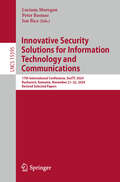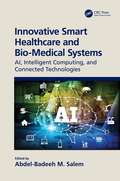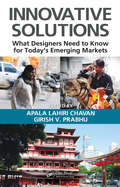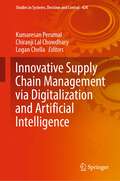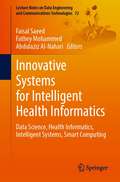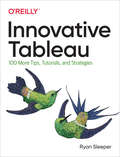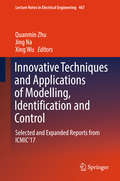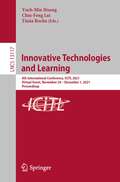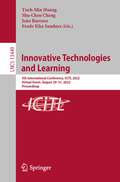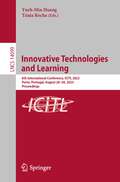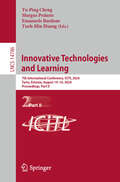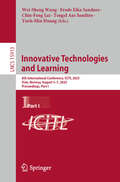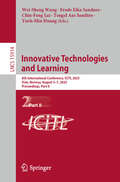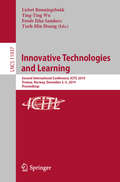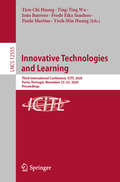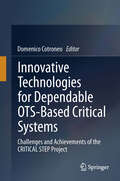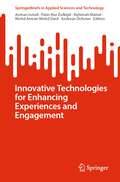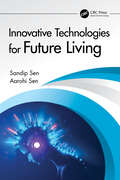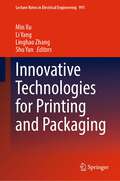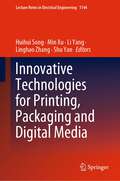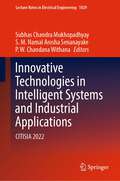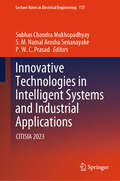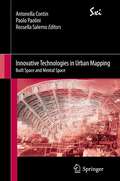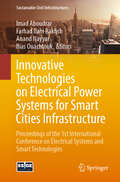- Table View
- List View
Innovative Security Solutions for Information Technology and Communications: 17th International Conference, SecITC 2024, Bucharest, Romania, November 21–22, 2024, Revised Selected Papers (Lecture Notes in Computer Science #15595)
by Ion Bica Peter Roenne Luciana MoroganThis book constitutes revised selected papers from the thoroughly refereed conference proceedings of the 17th International Conference on Innovative Security Solutions for Information Technology and Communications, SecITC 2024, which took place in Bucharest, Romania, in November 2024. The 16 full papers presented in these proceedings were carefully reviewed and selected from 49 submissions. The book also contains two invited talks. This conference is focusing on all theoretical and practical aspects related to information technology and communications security.
Innovative Smart Healthcare and Bio-Medical Systems: AI, Intelligent Computing and Connected Technologies
by Salem, Abdel-Badeeh M.Advances in smart healthcare systems (SHS) and artificial intelligence (AI) domains highlight the need for ICT systems that aim not only to improve human quality of life but improve safety too. SHS bring together concepts and methodologies from various fields, such as communications and network systems, computer science, life sciences and healthcare. The well-known smart healthcare paradigms are; real-time monitoring devices, computer-aided surgery devices, telemedicine devices, population-based care devices, personalized medicine from a machine learning perspective, ubiquities intelligent computing, expert decision support systems, Health 2.0 and Internet of Things (IoT). This book presents models for the deployment of intelligent computing, information, and networking technologies to aid in preventing disease, improving the quality of care and lowering overall cost. It also discusses the potential role of the AI paradigms, computational intelligence and machine learning techniques which are used in developing the SHS. It will provide examples of potential usage of such technology in smart healthcare and and bio-medical systems. It will be an important read for researchers and professionals working in smart healthcare systems, as well as those working in the individual areas of networks, artificial intelligence and healthcare who want to see how an interdisciplinary approach can enhance the current technology.
Innovative Solutions: What Designers Need to Know for Today's Emerging Markets
by Apala Lahiri Chavan Girish V. PrabhuExpanding into emerging markets brings with it a specific set of challenges for designing products and services. Not only do cultural differences play a role in what, how, and why customers behave the way they do, but existing technologies, distribution channels, and the wants and needs of consumers become additional challenges when establishing ma
Innovative Supply Chain Management via Digitalization and Artificial Intelligence (Studies in Systems, Decision and Control #424)
by Chiranji Lal Chowdhary Kumaresan Perumal Logan ChellaThis book focuses on the impact of artificial intelligence (AI) and machine learning (ML) models on supply chain operations in industry 4.0. The chapters illustrate the AI and ML models for all functional areas of operations in SCM. The book also includes examples using ML models like handling supply-to-demand imbalances, triggering automated responses, and reinforcing customer relationships. It describes the evolution of blockchain technology coupled with the ability to automate business logic for the transparency of goods, infrastructure, products, and licenses in software. The book also includes case studies that provide a problem statement and industry overcome by applying ML and AI technologies. This book is suitable for undergraduates, postgraduates, industrial professionals, business executives, entrepreneurs, and freelancers to encourage practical learning on AI and ML algorithms in SCM 4.0. Additionally, this book will provide computer science and information system professionals with the latest technologies embedded in the corporate world.
Innovative Systems for Intelligent Health Informatics: Data Science, Health Informatics, Intelligent Systems, Smart Computing (Lecture Notes on Data Engineering and Communications Technologies #72)
by Faisal Saeed Fathey Mohammed Abdulaziz Al-NahariThis book presents the papers included in the proceedings of the 5th International Conference of Reliable Information and Communication Technology 2020 (IRICT 2020) that was held virtually on December 21–22, 2020. The main theme of the book is “Innovative Systems for Intelligent Health Informatics”. A total of 140 papers were submitted to the conference, but only 111 papers were published in this book. The book presents several hot research topics which include health informatics, bioinformatics, information retrieval, artificial intelligence, soft computing, data science, big data analytics, Internet of things (IoT), intelligent communication systems, information security, information systems, and software engineering.
Innovative Tableau: 100 More Tips, Tutorials, and Strategies
by Ryan SleeperLevel up with Tableau to build eye-catching, easy-to-interpret data visualizations. In this follow-up guide to Practical Tableau, author Ryan Sleeper takes you through a collection of unique tips and tutorials for using this popular software. Beginning to advanced Tableau users will learn how to go beyond Show Me to make better charts and learn dozens of tricks to improve both the author and user experience.Featuring many approaches he developed himself, Ryan shows you how to create charts that empower Tableau users to explore, understand, and derive value from their data. He also shares many of his favorite tricks that enabled him to become a Tableau Zen Master, Tableau Public Visualization of the Year author, and Tableau Global Iron Viz Champion.Learn what’s new in Tableau since Practical Tableau was releasedExamine unique new charts—timelines, custom gauges, and leapfrog charts—plus innovations to traditional charts such as highlight tables, scatter plots, and mapsGet tips that can help make a Tableau developer’s life easierUnderstand what developers can do to make users’ lives easier
Innovative Techniques and Applications of Modelling, Identification and Control: Selected And Expanded Reports From Icmic'17 (Lecture Notes In Electrical Engineering #467)
by Quanmin Zhu Jing Na Xing WuThis book presents the most important findings from the 9th International Conference on Modelling, Identification and Control (ICMIC’17), held in Kunming, China on July 10–12, 2017. It covers most aspects of modelling, identification, instrumentation, signal processing and control, with a particular focus on the applications of research in multi-agent systems, robotic systems, autonomous systems, complex systems, and renewable energy systems.The book gathers thirty comprehensively reviewed and extended contributions, which help to promote evolutionary computation, artificial intelligence, computation intelligence and soft computing techniques to enhance the safety, flexibility and efficiency of engineering systems. Taken together, they offer an ideal reference guide for researchers and engineers in the fields of electrical/electronic engineering, mechanical engineering and communication engineering.
Innovative Technologies and Learning: 4th International Conference, ICITL 2021, Virtual Event, November 29 – December 1, 2021, Proceedings (Lecture Notes in Computer Science #13117)
by Yueh-Min Huang Chin-Feng Lai Tânia RochaThis book constitutes the refereed proceedings of the 4th International Conference on Innovative Technologies and Learning, ICITL 2021, held in November/December 2021. Due to COVID-19 pandemic the conference was held virtually. The 59 full papers presented together with 2 short papers were carefully reviewed and selected from 110 submissions. The papers are organized in the following topical sections: Artificial Intelligence in Education; Augmented, Virtual and Mixed Reality in Education; Computational Thinking in Education; Design Framework and Model for Innovative learning; Education Practice Issues and Trends; Educational Gamification and Game-based Learning; Innovative Technologies and Pedagogies Enhanced Learning; Multimedia Technology Enhanced Learning; Online Course and Web-Based Environment; and Science, Technology, Engineering, Arts and Design, and Mathematics.
Innovative Technologies and Learning: 5th International Conference, ICITL 2022, Virtual Event, August 29–31, 2022, Proceedings (Lecture Notes in Computer Science #13449)
by Yueh-Min Huang Frode Eika Sandnes João Barroso Shu-Chen ChengThis book constitutes the refereed proceedings of the 5th International Conference on Innovative Technologies and Learning, ICITL 2022, held in Porto, Portugal, in August 2022. The 53 full papers presented together with 3 short papers were carefully reviewed and selected from 123 submissions. ICITL focuses on artificial intelligence in education, VR/AR/MR/XR in education, design and framework of learning systems, pedagogies to innovative technologies and learning, application and design of innovative learning.
Innovative Technologies and Learning: 6th International Conference, ICITL 2023, Porto, Portugal, August 28–30, 2023, Proceedings (Lecture Notes in Computer Science #14099)
by Yueh-Min Huang Tânia RochaThis book constitutes the refereed proceedings of the 6th International Conference on Innovative Technologies and Learning, ICITL 2023, held in Porto, Portugal, during August 28–30, 2023. The 64 full papers included in this book were carefully reviewed and selected from 147 submissions. They cover a wide range of many different research topics, such as: artificial intelligence in education; computational thinking in education; design and framework of learning systems; pedagogies to innovative technologies and learning; STEM/STEAM education; VR/AR/MR/XR in education; and application and design of innovative learning software.
Innovative Technologies and Learning: 7th International Conference, ICITL 2024, Tartu, Estonia, August 14–16, 2024, Proceedings, Part I (Lecture Notes in Computer Science #14785)
by Yueh-Min Huang Emanuele Bardone Yu-Ping Cheng Margus PedasteThe two-volume set LNCS 14785 and 14786 constitutes the refereed post-conference proceedings of the 7th International Conference on Innovative Technologies and Learning, ICITL 2024, Tartu, Estonia, during August 14 -16, 2024. The 60 full papers included in this book were carefully reviewed and selected from 131 submissions. They were organized in topical sections as follows: Part One : Artificial Intelligence in Education; Computational Thinking in Education; Design and Framework of Learning Systems and Pedagogies to Innovative Technologies and Learning. Part Two : STEM/STEAM Education; VR/AR/MR/XR in Education; and Application and Design of Generative Artificial Intelligence in Education.
Innovative Technologies and Learning: 7th International Conference, ICITL 2024, Tartu, Estonia, August 14–16, 2024, Proceedings, Part II (Lecture Notes in Computer Science #14786)
by Yueh-Min Huang Emanuele Bardone Yu-Ping Cheng Margus PedasteThe two-volume set LNCS 14785 and 14786 constitutes the refereed conference proceedings of the 7th International Conference on Innovative Technologies and Learning, ICITL 2024, Tartu, Estonia, during August 14 -16, 2024. The 60 full papers included in this book were carefully reviewed and selected from 131 submissions. They were organized in topical sections as follows: Part One : Artificial Intelligence in Education; Computational Thinking in Education; Design and Framework of Learning Systems and Pedagogies to Innovative Technologies and Learning. Part Two : STEM/STEAM Education; VR/AR/MR/XR in Education; and Application and Design of Generative Artificial Intelligence in Education.
Innovative Technologies and Learning: 8th International Conference, ICITL 2025, Oslo, Norway, August 5–7, 2025, Proceedings, Part I (Lecture Notes in Computer Science #15913)
by Yueh-Min Huang Frode Eika Sandnes Chin-Feng Lai Wei-Sheng Wang Tengel Aas SandtrøThe two-volume set, LNCS 15913 and 15914, constitutes the refereed conference proceedings of the 8th International Conference on Innovative Technologies and Learning, ICITL 2025, held in Oslo, Norway, during August 5–7, 2025. The 82 papers included in these proceedings were carefully reviewed and selected from 214 submissions. The papers are organized in the following topical sections: Part I: Artificial Intelligence in Education; Computational Thinking in Education; Design and Framework of Learning Systems; VR/AR/MR/XR in Education. Part II: Pedagogies to Innovative Technologies and Learning; STEM/STEAM Education; Application and Design of Generative Artificial Intelligence in Education.
Innovative Technologies and Learning: 8th International Conference, ICITL 2025, Oslo, Norway, August 5–7, 2025, Proceedings, Part II (Lecture Notes in Computer Science #15914)
by Yueh-Min Huang Frode Eika Sandnes Chin-Feng Lai Wei-Sheng Wang Tengel Aas SandtrøThe two-volume set, LNCS 15913 and 15914, constitutes the refereed conference proceedings of the 8th International Conference on Innovative Technologies and Learning, ICITL 2025, held in Oslo, Norway, during August 5–7, 2025. The 82 papers included in these proceedings were carefully reviewed and selected from 214 submissions. The papers are organized in the following topical sections: Part I: Artificial Intelligence in Education; Computational Thinking in Education; Design and Framework of Learning Systems; VR/AR/MR/XR in Education. Part II: Pedagogies to Innovative Technologies and Learning; STEM/STEAM Education; Application and Design of Generative Artificial Intelligence in Education.
Innovative Technologies and Learning: Second International Conference, ICITL 2019, Tromsø, Norway, December 2–5, 2019, Proceedings (Lecture Notes in Computer Science #11937)
by Yueh-Min Huang Ting-Ting Wu Lisbet Rønningsbakk Frode Eika SandnesThis book constitutes the refereed proceedings of the Second International Conference on Innovative Technologies and Learning, ICITL 2019, held in Tromsø, Norway, in December 2019. The 85 full papers presented together with 4 short papers were carefully reviewed and selected from 189 submissions. The papers are organized in the following topical sections: application and design of innovative learning software; artificial intelligence and data mining in education; augmented and virtual reality in education; computational thinking in education; design and framework of learning systems; educational data analytics techniques and adaptive learning applications; evaluation, assessment and test; innovative learning in education; mobile learning; new perspectives in education; online course and web-based environment; pedagogies to innovative technologies; social media learning; technologies enhanced language learning; and technology and engineering education.
Innovative Technologies and Learning: Third International Conference, ICITL 2020, Porto, Portugal, November 23–25, 2020, Proceedings (Lecture Notes in Computer Science #12555)
by Yueh-Min Huang Ting-Ting Wu Tien-Chi Huang Frode Eika Sandnes João Barroso Paulo MartinsThis book constitutes the refereed proceedings of the Second International Conference on Innovative Technologies and Learning, ICITL 2020, held in Porto, Portugal, in November 2020. The 65 full papers presented together with 2 short papers were carefully reviewed and selected from 127 submissions. The papers are organized in the following topical sections: Augmented and Virtual Reality in Education; Educational Data Mining and Learning Analytics; Emerging Issues and Trends in Education; Innovative Learning in Education; Online Course and Web-Based Environment; Technology-Enhanced Learning; Application and Design of Innovative Learning Software; and Science, Technology, Engineering, Arts and Design, and Mathematics.Due to the Corona pandemic this event was held virtually.
Innovative Technologies for Dependable OTS-Based Critical Systems
by Domenico CotroneoThe demand for large-scale dependable, systems, such as Air Traffic Management, industrial plants and space systems, is attracting efforts of many word-leading European companies and SMEs in the area, and is expected to increase in the near future. The adoption of Off-The-Shelf (OTS) items plays a key role in such a scenario. OTS items allow mastering complexity and reducing costs and time-to-market; however, achieving these goals by ensuring dependability requirements at the same time is challenging. CRITICAL STEP project establishes a strategic collaboration between academic and industrial partners, and proposes a framework to support the development of dependable, OTS-based, critical systems. The book introduces methods and tools adopted by the critical systems industry, and surveys key achievements of the CRITICAL STEP project along four directions: fault injection tools, V&V of critical systems, runtime monitoring and evaluation techniques, and security assessment.
Innovative Technologies for Enhancing Experiences and Engagement (SpringerBriefs in Applied Sciences and Technology)
by Andreas Öchsner Azman Ismail Mohd Amran Mohd Daril Fatin Nur Zulkipli Rahimah MahatThe book showcases how the technologies are transforming entertainment, education, and professional training, offering readers real-world examples of their applications. "Innovative Technologies for Enhancing Experiences and Engagement" is an enlightening guide that reveals how emerging technologies are shaping our world, offering insights into the evolving digital landscape and inspiring a future of more personalized, immersive, and engaging experiences.
Innovative Technologies for Future Living
by Sandip Sen Aarohi SenAs of January 2023, there are 5 billion users of the internet. People who use technology and want to know about it—in simple language, without jargon. Many of those nurture dreams and aspirations to be quicker, smarter and ‘be the change.’ We bring to them relatable stories of everyday users, understood by consumers and gadget freaks alike. We start with the Internet of Things (IoT) and show how consumers are using smart devices that teach them to manage their homes, travel and lifestyle through their smartphones. We see how cloud computing and artificial intelligence (AI) are enabling them to give feedback to IoT devices, and extracting multiple services from household products like the humble LED light, or the refrigerator, or sophisticated jet engines, or combined harvesters. As devices turn smart and AI and robots enter our workspace they run the risk of being hacked. So techies developed the Blockchain, with encrypted text that would secure digital assets. But with it arrived cryptocurrencies that threaten to bring unprecedented speculation, money laundering and cyber crimes. We also explore new opportunities in telehealth, distant education and metaworld, and the strides made in digital transformation that has, in less than five years, empowered over 2 billion people across the world, giving them access to cost effective banking, education, travel, energy, food and health services. But the same technologies are used to fight wars and disrupt supply chains that cause acute distress and worldwide recessions. The book is relevant because the changes happening now are not incremental but tectonic. This opens the door to a future that is more fascinating and threatening than fiction. Read on to find out more.
Innovative Technologies for Printing and Packaging (Lecture Notes in Electrical Engineering #991)
by Min Xu Li Yang Shu Yan Linghao ZhangThis book includes original, peer-reviewed research papers from the 13th China Academic Conference on Printing and Packaging (CACPP 2022), held in Jinan, China, on November 10-12, 2022. The proceedings cover the recent findings in color science and technology, image processing technology, digital media technology, mechanical and electronic engineering and numerical control, materials and detection, digital process management technology in printing and packaging, and other technologies. As such, the book is of interest to university researchers, R&D engineers, and graduate students in the field of graphic arts, packaging, color science, image science, material science, computer science, digital media, network technology, and smart manufacturing technology.
Innovative Technologies for Printing, Packaging and Digital Media (Lecture Notes in Electrical Engineering #1144)
by Min Xu Li Yang Shu Yan Linghao Zhang Huihui SongThis book includes original, peer-reviewed research papers from the 14th China Academic Conference on Printing and Packaging (CACPP 2023), held in Beijing, China on November 24-26, 2023. The proceedings cover the latest findings in color science and technology, image processing technology, digital media technology, mechanical and electronic engineering and numerical control, materials and detection, printing and packaging technology, and so on. As such, the book is of interest to university researchers, R&D engineers and graduate students in the fields of color science, image science, materials science, computer science, digital media, network technology, smart manufacturing technology and printing and packaging.
Innovative Technologies in Intelligent Systems and Industrial Applications: CITISIA 2022 (Lecture Notes in Electrical Engineering #1029)
by Subhas Chandra Mukhopadhyay S. M. Namal Arosha Senanayake P. W. Chandana WithanaThis book presents the proceedings of the 7th International Conference on Innovative Technologies in Intelligent Systems & Industrial Application (CITISIA), held in virtual mode in Kuala Lumpur, Malaysia, and Sydney, Australia on November 16-18, 2022. It showcases advances and innovations in Industry 4.0, smart society 5.0, mobile technologies, smart manufacturing, smart data fusion, hybrid intelligence, cloud computing, and digital society.
Innovative Technologies in Intelligent Systems and Industrial Applications: CITISIA 2023 (Lecture Notes in Electrical Engineering #117)
by Subhas Chandra Mukhopadhyay S. M. Namal Arosha Senanayake P. W. C. PrasadThis book presents the proceedings of the 8th International Conference on Innovative Technologies in Intelligent Systems & Industrial Application (CITISIA), held in virtual mode in Sydney, Australia and Kuala Lumpur, Malaysia, on November 16-18, 2023. It showcases advances and innovations in Industry 4.0, smart society 5.0, mobile technologies, smart manufacturing, smart data fusion, hybrid intelligence, cloud computing, and digital society.
Innovative Technologies in Urban Mapping
by Antonella Contin Paolo Paolini Rossella SalernoThe book presents a comprehensive vision of the impact of ICT on the contemporary city, heritage, public spaces and meta-cities on both urban and metropolitan scales, not only in producing innovative perspectives but also related to newly discovered scientific methods, which can be used to stimulate the emerging reciprocal relations between cities and information technologies. Using the principles established by multi-disciplinary interventions as examples and then expanding on them, this book demonstrates how by using ICT and new devices, metropolises can be organized for a future that preserves the historic nucleus of the city and the environment while preparing the necessary expansion of transportation, housing and industrial facilities.
Innovative Technologies on Electrical Power Systems for Smart Cities Infrastructure: Proceedings of the 1st International Conference on Electrical Systems and Smart Technologies (Sustainable Civil Infrastructures)
by Anand Nayyar Farhad Ilahi Bakhsh Imad Aboudrar Ilias OuachtoukThis book compiles selected papers from the International Conference on Electrical Systems and Smart Technologies (ICESST 2024), held in Dakhla, Morocco (December 11-13, 2024). It presents key research insights, offering a structured exploration of innovations in electrical systems and smart technologies. The first section covers power electronics and electrical systems, focusing on advanced control techniques, electrical machines, and drives. It then transitions to computational intelligence and soft computing, highlighting the role of machine learning and deep learning in enhancing modern electrical systems. Next, the book delves into IoT and embedded systems, emphasizing their impact on smart infrastructure and smart cities, addressing challenges and solutions in efficiency and effectiveness. The smart grids and power systems section explores energy management, renewable energy integration, and forecasting, underscoring sustainability in modern power systems. This leads to a discussion on sustainable energy solutions, covering hydrogen energy, fuel cells, storage systems, and electrical mobility. Finally, the book examines automation, robotics, and control technologies, showcasing advancements in mechatronics, industrial automation, and AI-driven robotics. This comprehensive guide provides valuable insights into current trends, challenges, and future directions in electrical engineering and smart technologies, making it essential for professionals, researchers, and students.
